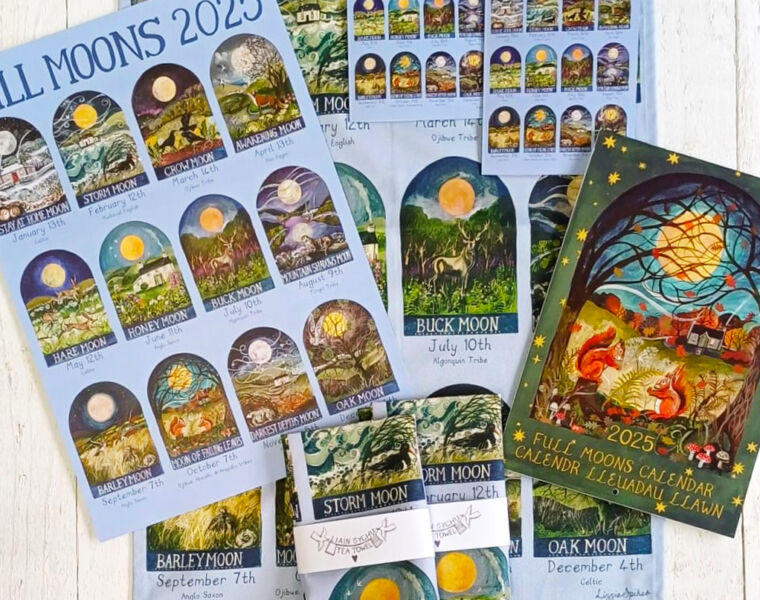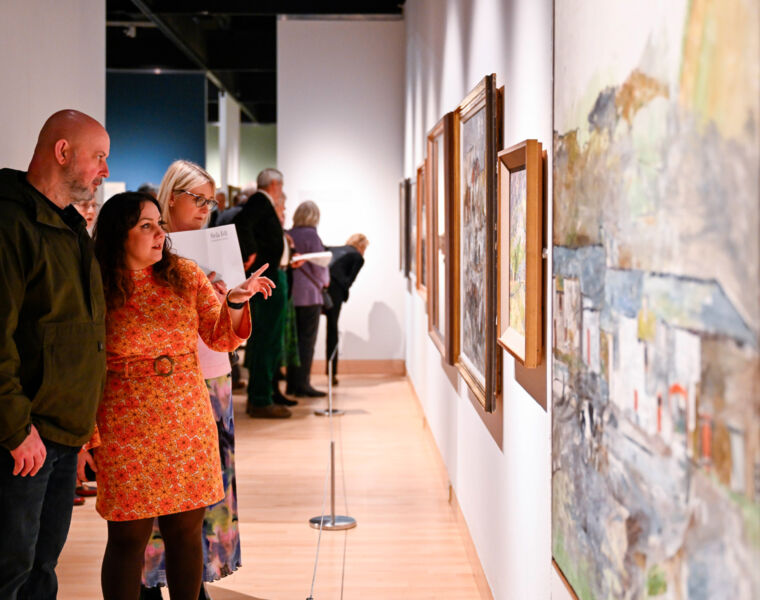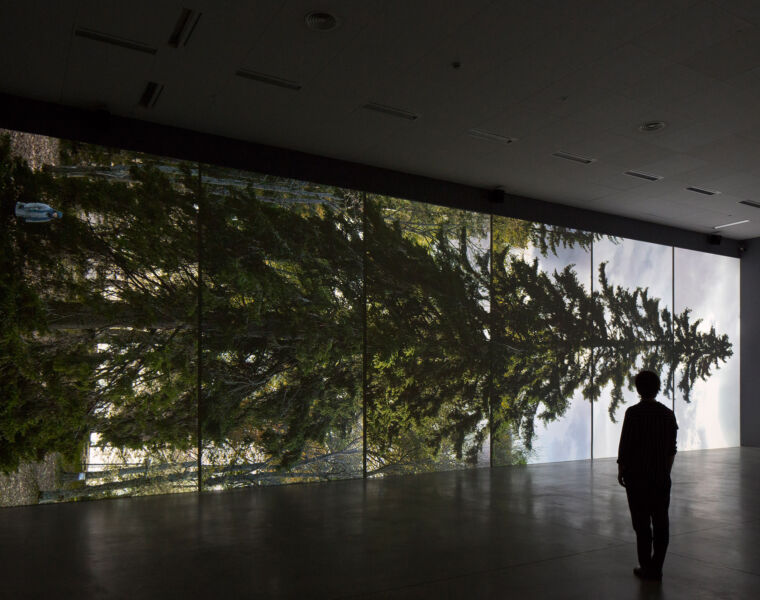
Today, the Design Museum has unveiled a new free display titled Tomorrow’s Wardrobe, which celebrates a more sustainable future for fashion.
Opening to the public tomorrow to coincide with London Fashion Week and London Design Festival, Tomorrow’s Wardrobe explores the potential for a more environmentally conscious fashion industry.
Visitors will see textiles, technology, and garments that showcase initiatives to reduce the industry’s environmental and social impact across clothes production, design, and use. Highlights include an Ahluwalia upcycled polo shirt, a bag produced in collaboration with Stella McCartney and Ponda, garments from Toast’s recent visible repair line, and a pair of Salomon shoes made with Ranra for disassembly.
This is the second display on the museum’s new Future Observatory display space on its second floor, which showcases ongoing design research responding to climate emergencies.
Future Observatory is the Design Museum’s national research programme for the green transition. It aims to champion new design thinking on environmental issues by curating exhibitions, programming events, and funding and publishing research. Based at the museum, it is coordinated in partnership with the UKRI Arts and Humanities Research Council.
 Tomorrow’s Wardrobe. Photography by Aaron Parsons.
Tomorrow’s Wardrobe. Photography by Aaron Parsons.
Though an important part of the UK economy, the significant environmental and social impact of the fashion industry is felt across the world and spans textile manufacture, the design process, and the way we consume clothes. Production is only increasing, with annual garment production doubling since 2000 and expected to increase by 60% by 2030.
The upstream supply chain greatly impacts the rest of the fashion ecosystem, with an estimated 80% of a product’s environmental impact determined at the design stage. Tomorrow’s Wardrobe showcases research across different parts of the industry to reduce this damage by cutting waste, innovating with new materials and methods, producing longer-lasting clothes and changing how we – everyday wearers of clothes – think about what ends up in our wardrobes.
The first section of the display introduces visitors to the scale of the problem and the urgent need for change. Visitors can explore a commissioned interactive tool to learn more about fabrics and textiles, made as a collaboration between UAL researcher Laetitia Forst and graphic design studio ACRE. This section includes an outfit styled by Isabelle Landicho and the Earth Issue, with pieces by EA Williams, Lizandro Acera, SKIN SERIES and Olaniyi Studio.
The display then follows three sections—Textile Landscapes, In the Studio, and Your Wardrobe—which take visitors along the journey from farms and factories to design studios and onto their own wardrobes. Each section features a large-scale commissioned illustration by Max Gunther, made in collaboration with a group of design researchers that imagines the fashion landscape for the late 2030s.
Textile Landscapes focuses on the production of fabrics, materials and textiles. Visitors will learn about the UK as a productive landscape where materials for clothing are grown, farmed, harvested, spun and weaved in ways that can support thriving biodiversity.
 Yellow jumper designed by Phoebe English, produced in partnership with South East England Fibreshed, in Tomorrow’s Wardrobe. Photography by Aaron Parsons for the Design Museum.
Yellow jumper designed by Phoebe English, produced in partnership with South East England Fibreshed, in Tomorrow’s Wardrobe. Photography by Aaron Parsons for the Design Museum.
Visitors will see a jumper designed by Phoebe English and produced in partnership with South East Fibreshed, which is part of the global Fibreshed movement that supports the production of wool products in time with the slow cyclical rhythms of sheep farming.
The display also explores ways to harness agricultural waste for textile production. Visitors will be able to see yarn made from potato plant waste by startup Fibe. Other highlights include a bag made in collaboration between Stella McCartney and Ponda, who developed a regenerative fibre for use in puffer jackets made from wetland plants.
‘In the Studio’ looks at the new ways designers are working to reduce their environmental impact. Visitors will learn about how high-tech innovations such as artificial intelligence and robotics blend with low-tech solutions such as design for disassembly and upcycling to define the fashion studio of the future.
 Ahluwalia Sahara Short Sleeve Polo. Photography by Aaron Parsons for the Design Museum.
Ahluwalia Sahara Short Sleeve Polo. Photography by Aaron Parsons for the Design Museum.
This section features a polo shirt made from upcycled vintage sports shirts by fashion brand Ahluwalia, which the Design Museum acquired earlier this summer for its permanent collection.
Other projects include a pair of shoes made for disassembly produced in collaboration between outerwear brands Ranra and Salomon. Visitors will also learn about the UK’s first polyester recycling plant and see a school blazer designed for recycling by Project Plan B.
Your Wardrobe explores how our relationships with our clothes are changing in the context of the climate emergency. Visitors will consider ways to rethink wardrobes, from extending the lifecycle of clothes through repair to developing clothing that can be adapted in both form and function by its wearer.
The display spotlights Save Your Wardrobe, a digital platform that connects people across the UK to repair and alteration services. Also on display are garments made by fashion brand Toast, part of its 2024 line of creatively repaired garments that celebrate the aesthetic appeal of repair. Visitors will also be able to learn about the material backstories of clothes by scanning the Digital Product Passport (DPP) of a pair of jeans made by Nobody’s Child.
 Jeans by Nobody’s Child, featuring a Digital Product Passport. Photography by Aaron Parsons for the Design Museum.
Jeans by Nobody’s Child, featuring a Digital Product Passport. Photography by Aaron Parsons for the Design Museum.
DPPs are soon to be a legal requirement of garment production in the European Union and contain data on how and where the garment was manufactured and how it can be recycled. This section also features 3D-scanned and printed footwear from Vivobarefoot and a ‘modular’ shirt developed by the Royal College of Art’s Textiles Circularity Centre with designer Morag Seaton.
Curatorial advisors Kate Goldsworthy (UAL), Jalaj Hora (Nike), and Susan Postlethwaite (Manchester Metropolitan University) have supported the display.
George Kafka, Curator of Tomorrow’s Wardrobe, said, “Tomorrow’s Wardrobe demonstrates the diverse and far-reaching action being taken across the fashion industry to deal with the monumental environmental challenges it faces. The display shows that change can’t come from one group alone, but that collaboration across sectors – from farmers to manufacturers, brands to policymakers, and designers to consumers – will begin setting us in the right direction so that the clothes we wear don’t cost the earth.”
 Falabella bag with BioPuff padding, by Stella McCartney in partnership with Ponda, in Tomorrow’s Wardrobe. Photography by Aaron Parsons for the Design Museum.
Falabella bag with BioPuff padding, by Stella McCartney in partnership with Ponda, in Tomorrow’s Wardrobe. Photography by Aaron Parsons for the Design Museum.
Cher Potter, Curatorial Director of Future Observatory, said, “The UK has long been considered a ‘laboratory for fashion’, a site for brave experimentation and unbridled creativity. Today we see these unique capabilities being applied to the reimagining of the fashion industry itself. Researchers are transforming not only the way we wear our clothing but also the way we grow, design and produce them. At Future Observatory, we believe it is this holistic systems-level design that will drive a green transition.”
Fashion Designer Phoebe English said, “In our small way, we have been exploring how we can use the act of designing fashion to use up waste as we go along and begin to bring a tangible and practical link to our natural systems by making our work. We have become entirely divorced from nature and we hope as time goes by we can find a way of teaching ourselves how to become inseparable.”
Tomorrow’s Wardrobe
14 September 2024 – August 2025
Location: Future Observatory Display, 2nd floor
Tickets: Free (no booking required)
Photography by Aaron Parsons for The Design Museum.
![]()




You must be logged in to post a comment.